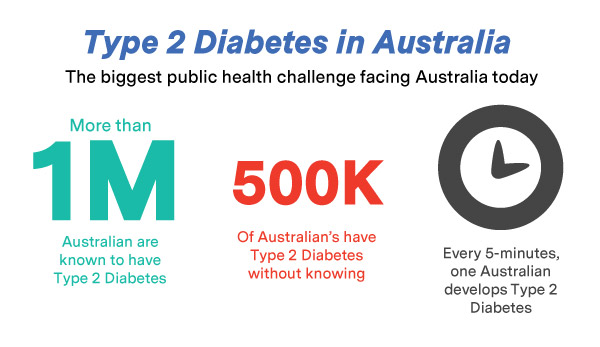What is type 2 diabetes?
Type 2 diabetes (T2DM) is a disease where the body progressively becomes resistant to insulin and/or gradually loses the capacity to produce sufficient insulin. T2DM is a condition that can develop over a long period of time, often years. It is associated with lifestyle factors that we can control (eg. diet, exercise) and is also strongly linked with genetic and family related risk factors. Unfortunately, the exact causes of T2DM are unknown.1
T2DM is the most common type of diabetes, representing up to 90 per cent of all cases of diabetes.1
The burden of type 2 diabetes in Australia
More than one million Australians are known to have type 2 diabetes,2 with a further 500,000 people estimated to have it without realising. Alarmingly, 280 Australians develop diabetes every day – that’s one person every 5 minutes. Type 2 diabetes – the fastest growing chronic disease in Australia – is undoubtedly one of the biggest public health challenges facing Australia today.3
Who is at risk?
Everybody above the age of 40 is considered to have an increased risk of developing T2DM (Aboriginal and Torres Strait Islander peoples above the age of 18 are considered to be at an increased risk).4
The following groups are considered to have a high risk of developing T2DM:4
- Those above 40 who are overweight or obese
- Those with a first-degree relative with diabetes
- Those who are considered to have a high-risk ethnicity (eg. Indian subcontinent or Pacific Islanders)
- Those with a history of a previous cardiovascular event (ie. heart attack or stroke)
- Females with a history of gestational diabetes
- Females with polycystic ovary syndrome
- Those taking antipsychotic medication
It is highly recommended that you visit your GP so that together you can calculate your risk of developing T2DM (as an example, your doctor might use the Australian type 2 diabetes risk assessment tool). After identifying your risk, your GP is in the best position to be able to recommend preventive activities or early treatment options.
How to detect type 2 diabetes (and its precursors)
There are three different tests, often used in combination, that your doctor might organise in order to find out if you have diabetes or not. These are:4
- Fasting blood glucose test: measuring the levels of sugar in your blood after you have fasted for a set period of time
- Oral glucose tolerance test: measuring the levels of sugar in your blood before (fasting), and two hours after, consuming 75g of glucose
- Glycated haemoglobin (HbA1c) test: a specific blood test that measures the percentage of haemoglobin (which carries oxygen to your tissues via your blood) that is bound to glucose
After organising one or more of these tests (note that repeat tests might be required), your doctor will be able to tell you whether or not you have diabetes (or are highly likely to). Alternatively, your doctor might determine that you have a condition that, whilst not being diabetes itself, could lead to diabetes. These are:4
- Impaired fasting glucose: A borderline fasting blood glucose test result
- Impaired glucose tolerance: A borderline oral glucose tolerance test (after two hours)
Type 2 diabetes prevention
If you are at risk of developing type 2 diabetes (those with identified risk factors and/or those who have previously had a borderline diabetes test), your doctor might recommend the following health prevention activities which have been proven to help reduce the risk of developing T2DM:
- Increase the time you do physical activity
This should include 30 minutes of brisk walking at least five times a week. - Lose weight
In those at risk, losing weight can reduce the risk of developing diabetes by about one half. - Follow a healthy, balanced, low-fat diet
This includes:- Consume a low amount of fat (<30% of total diet), particularly saturated fat (<10%)
- Consume high amounts of fibre
- Consume high amounts of cereals, legumes, vegetables and fruits with a low glycemic index
To assist with these goals, your doctor will be able to refer you to a dietitian and a physical activity program.4
For those with a history of gestational diabetes, remember to ask your doctor for pre-conception advice.4
References
- Diabetes Australia (online). Type 2 Diabetes [accessed 28 Jan 2019]. Available from: URL link
- Australian Institute of Health and Welfare (online). Diabetes snapshot [accessed 28 Jan 2019]. Available from: URL link
- Diabetes Australia (online). Diabetes in Australia [accessed 28 Jan 2019]. Available from: URL link
- Royal Australian College of General Practitioners. Guidelines for preventive activities in general practice. 9th edn, updated. East Melbourne, Vic; RACGP, 2018.
All content and media on the HealthEngine Blog is created and published online for informational purposes only. It is not intended to be a substitute for professional medical advice and should not be relied on as health or personal advice. Always seek the guidance of your doctor or other qualified health professional with any questions you may have regarding your health or a medical condition. Never disregard the advice of a medical professional, or delay in seeking it because of something you have read on this Website. If you think you may have a medical emergency, call your doctor, go to the nearest hospital emergency department, or call the emergency services immediately.









